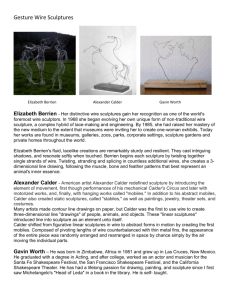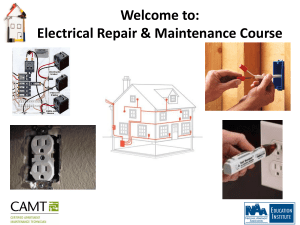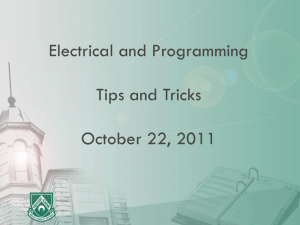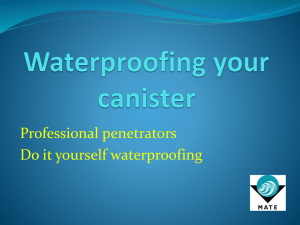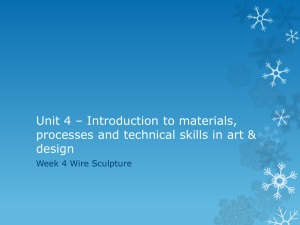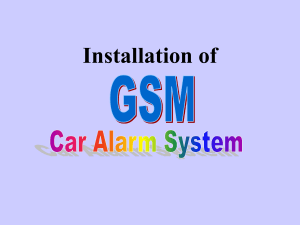Expressive Linear Sculpture
advertisement
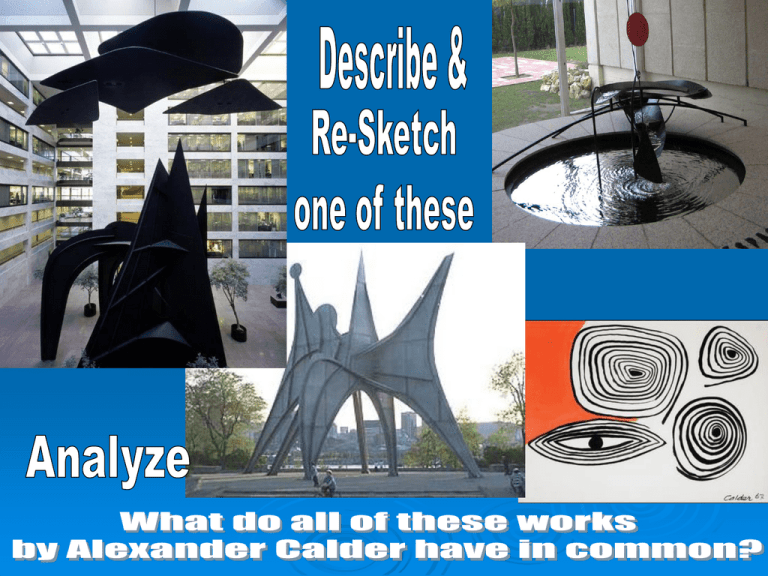
Expressive Linear Sculpture After being exposed to the work of Alexander Calder and others and experimenting with Line, students will receive 18 gauge wire and will experiment with wire formation techniques to create a three dimensional figure Students will be able to make better pieces of art after they are exposed, analyze and critique the work of Alexander Calder and create art that shows a variety of subject matter, focuses and motion: Objectives- Students will be able to Students will develop skill in utilizing line in a 3 dimensional context, experimenting with: a - outline b - contour line c - gesture line Identify art concepts in line artworks by artists and students Evaluate finished artwork Students will gain experience utilizing simple wire attachment techniques of twisting and crimping Students will explore a variety of techniques for mounting sculpture to the base Calder’s alteration of "form" are viewed from different angles, causing the relationship of the lines being used to change Mountains and Clouds (1976), by Alexander Calder, 612 inches x 900 inches Mercury Fountain (1937), by Alexander Calder Untitled gouache on paper by Alexander Calder, 1967, Do you think Calder is suggesting something about what “Man” is trying to express through the use of line? Man, a "stabile" by Alexander Calder; Terre des Hommes (Expo 67 fairground), Why do you think Calder made his “Man” look like this? Know the artist: Alexander Calder "My fan mail is enormous. Everyone is under six." ~ Alexander Calder 1898-1976, American sculptor, b. Philadelphia; son of a prominent sculptor, Alexander Stirling Calder. Among the most innovative modern sculptors, Calder was trained as a mechanical engineer. A toy maker obsessed with a love for the circus. He was credited for inventing the mobile, which is a basic toy hung over baby cribs Click on the link for more info and a video on Calder (14:09) At this point, “mobile” was synonymous with the term “kinetic art”, describing sculptural works in which motion is a defining property. While motor or crankdriven moving sculptures may have initially prompted it, the word “mobile” later came to refer more specifically to Calder’s freemoving creations. Where do you see visual movement in the sculptures? Compare & Contrast the creation / processes / materials involved in 2D and 3D artwork Now that you know some of the differences… Students will work with pen and ink / ball point pen, to create line drawings using outline, contour and gesture techniques that represent full and partial figurative subjects - emphasis is to be placed on illustration of form and emotion using line Kinds of Lines: Your drawing today should feature all of these Short/long, curved/straight, Broken/continuous Qualities of lines: thick/thin, hard/soft, clean/fuzzy Expressive lines: straight/rigid, diagonal/exciting, horizontal/restful, vertical/dignified, and undulating/energetic. Lines that describe an edge Overlapping Lines and shapes. Drawing your still life: Observe the object carefully and complete a contour line (outline) drawing (by trying to pick up their pencil from the paper AS FEW TIMES AS POSSIBLE!) Students should draw lightly at first Students will repeats steps 2 and 3 independently as I come around to check up and assess their work. Every 10 minutes they should rotate to a different station that has a different shape at it. They should continue the process until they fill up their paper. Students will get with one or two of their Clock Camaraderie partner to discuss the work that they have created. Such as the troubles they encountered, things they like and things they do not like. Extension: They will also practice BLIND CONTOUR DRAWINGS on a few of the objects in the room. Assessment: Did the student create unique Contour / Blind Contour drawings (AND NOT TRACING THE OBJECT) The painting was commissioned by the Spanish government to hang in the Spanish Pavilion at the World Fair in Paris, 1937. Guernica is Picasso's answer to the atrocities that were inflicted upon Guernica. It is a powerful work done a grand scale to highlight the futility of war and the suffering that it causes for all. Red Mobile, 1956. Painted sheet metal and metal rods These drawings capture the “Gesture” or the suggested, implied movement or rhythm a figure is showing. You can think of it as a “stick figure” in motion. Students will develop their understanding of movement by completing a series of gesture drawings, quick sketches that are based on careful observation. Focus of this project is primarily on line and trying to capture the gesture of the model. Most of these are 60sec gestures, concentrating on flow of force and motion, not proportion or likeness to the model (obviously!) Assessment: Did the student create a series of gesture drawings that capture the suggestion of movement? Critique your partner and provide some assistance on how they can create better gesture drawings? Assessment 4 Superior: Work shows an excellent grasp of all of the concepts explored in this project Range of sculptures created shows a comprehensive understanding of the figure and the expression of emotion through the use of line. The level of craftsmanship attended to in the creation and finishing of the work is exemplary. 3 Proficient: Work shows a good grasp of all of the major concepts explored in this project Range of sculpture created shows a good understanding of the figure and the expression of emotion through the use of line. A careful level of craftsmanship is evident in the creation and finishing of the sculptures. 2 Emerging : Work shows some some understanding of the major concepts explored in this project Sculptures created for this project meet the criteria of the various assignments for the most part and suggest an attempt to depict emotion through the use of line. Some care has been taken in the creation and finishing of the sculptures although there is inconsistency evident in the level of care throughout the range of work completed. 1 Novice: Work shows only occasional understanding of some of the major concepts explored in this project Sculptures created for this project do not necessarily meet the criteria of the various assignments and either do not or only slightly suggest an emotional component through the use of the line. Little or no care is evident in the craftsmanship of the projects which may or may not have been totally completed. Examples of Student Wire Sculptures Students will work on a series of sculptures. Drawings are to be used as practice for visualization of sculpture subjects /utilization of wire Students may work on the 3 sculpture assignments in any order that they choose, but discussion of essential differences between expectations involved in assignments (Description), needs to take place before, during and after completion of works Some ideas… You can team up with a partner to complete these and you may start on any one of them: 1) Wire sculpture of your face or partner’s 2) A figure that shows movement (could be human or animal) 3) A figure at rest. Which could be an abstract design that shows expression of emotion through use of line Safety with the wire The wire does have potential to poke an eye out or scrape skin Please always wear your goggles and NEVER swing wire around like a lasso or anything inappropriately You will only receive a 12” long piece of wire to work with at a time. DO NOT MISUSE IT OR THE TOOLS OR YOU ARE OUT The three wire technique Distribute three strands of wire per student, and one or two wire cutters per table. Students may wish to swap different color wires back and forth. Students should focus on seeing how many different things they can do with just three wires. They can doodle around, making little cartoon figures. Or, if there's something they enjoy looking at, a flower or a bug, have them look at it very closely and see if they can make something like it out of the wire. Encourage them to really look at the objects they enjoy (people, animals, sports cars), and observe a few important aspects to try and get down in wire. If you can master the Three-Wire technique, you will be ready for the more advanced objects and techniques in wire art. Experiment with wire bending techniques Plot out your artwork first by making sketches. How do you think you can take “line” such as the wire and turn it into something threedimensional? Bend, crimp and twist the wire and manipulate it with your tools. Eventually your wire sculpture will be mounted through a hole in a block of wood. The wood isn’t that big, so REALLY consider the weight of your sculpture or it might fall over. How does this modern New York artist create three-dimensional forms out of just line Safety with the wire The wire does have potential to poke an eye out or scrape skin Please always wear your goggles and NEVER swing wire around like a lasso or anything inappropriately You will only receive a 12” long piece of wire to work with at a time. DO NOT MISUSE IT OR THE TOOLS OR YOU ARE OUT Assessment 4 Superior: Work shows an excellent grasp of all of the concepts explored in this project Range of sculptures created shows a comprehensive understanding of the figure and the expression of emotion through the use of line. The level of craftsmanship attended to in the creation and finishing of the work is exemplary. 3 Proficient: Work shows a good grasp of all of the major concepts explored in this project Range of sculpture created shows a good understanding of the figure and the expression of emotion through the use of line. A careful level of craftsmanship is evident in the creation and finishing of the sculptures. 2 Emerging : Work shows some some understanding of the major concepts explored in this project Sculptures created for this project meet the criteria of the various assignments for the most part and suggest an attempt to depict emotion through the use of line. Some care has been taken in the creation and finishing of the sculptures although there is inconsistency evident in the level of care throughout the range of work completed. 1 Novice: Work shows only occasional understanding of some of the major concepts explored in this project Sculptures created for this project do not necessarily meet the criteria of the various assignments and either do not or only slightly suggest an emotional component through the use of the line. Little or no care is evident in the craftsmanship of the projects which may or may not have been totally completed. Know the artist: Elisabeth Berrien This modern wire artist from California has some notes about working with wire: Structure: There are endless ways to create a structure. The weaker it is, the more times you will have to reform it. Practice & Experiment: There really are no set rules about working with wire, but it is suggested to at first just experiment. Get a couple of pieces of wire and form them into as many different things as possible by bending and looping. Safety with the wire The wire does have potential to poke an eye out or scrape skin Please always wear your goggles and NEVER swing wire around like a lasso or anything inappropriately You will only receive a 12” long piece of wire to work with at a time. DO NOT MISUSE IT OR THE TOOLS OR YOU ARE OUT Assessment 4 Superior: Work shows an excellent grasp of all of the concepts explored in this project Range of sculptures created shows a comprehensive understanding of the figure and the expression of emotion through the use of line. The level of craftsmanship attended to in the creation and finishing of the work is exemplary. 3 Proficient: Work shows a good grasp of all of the major concepts explored in this project Range of sculpture created shows a good understanding of the figure and the expression of emotion through the use of line. A careful level of craftsmanship is evident in the creation and finishing of the sculptures. 2 Emerging : Work shows some some understanding of the major concepts explored in this project Sculptures created for this project meet the criteria of the various assignments for the most part and suggest an attempt to depict emotion through the use of line. Some care has been taken in the creation and finishing of the sculptures although there is inconsistency evident in the level of care throughout the range of work completed. 1 Novice: Work shows only occasional understanding of some of the major concepts explored in this project Sculptures created for this project do not necessarily meet the criteria of the various assignments and either do not or only slightly suggest an emotional component through the use of the line. Little or no care is evident in the craftsmanship of the projects which may or may not have been totally completed.
